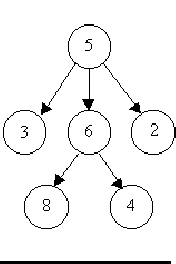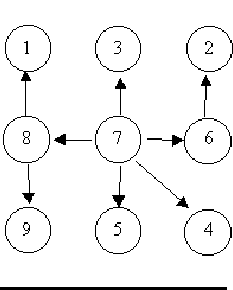Is It A Tree?
Time Limit: 2000/1000 MS (Java/Others) Memory Limit: 65536/32768 K (Java/Others)
Total Submission(s): 32554 Accepted Submission(s):
7447
Problem Description
A tree is a well-known data structure that is either
empty (null, void, nothing) or is a set of one or more nodes connected by
directed edges between nodes satisfying the following properties.
There is exactly one node, called the root, to which no directed edges point.
Every node except the root has exactly one edge pointing to it.
There is a unique sequence of directed edges from the root to each node.
For example, consider the illustrations below, in which nodes are represented by circles and edges are represented by lines with arrowheads. The first two of these are trees, but the last is not.



In this problem you will be given several descriptions of collections of nodes connected by directed edges. For each of these you are to determine if the collection satisfies the definition of a tree or not.
There is exactly one node, called the root, to which no directed edges point.
Every node except the root has exactly one edge pointing to it.
There is a unique sequence of directed edges from the root to each node.
For example, consider the illustrations below, in which nodes are represented by circles and edges are represented by lines with arrowheads. The first two of these are trees, but the last is not.



In this problem you will be given several descriptions of collections of nodes connected by directed edges. For each of these you are to determine if the collection satisfies the definition of a tree or not.
Input
The input will consist of a sequence of descriptions
(test cases) followed by a pair of negative integers. Each test case will
consist of a sequence of edge descriptions followed by a pair of zeroes Each
edge description will consist of a pair of integers; the first integer
identifies the node from which the edge begins, and the second integer
identifies the node to which the edge is directed. Node numbers will always be
greater than zero.
Output
For each test case display the line ``Case k is a
tree." or the line ``Case k is not a tree.", where k corresponds to the test
case number (they are sequentially numbered starting with 1).
Sample Input
6 8 5 3 5 2 6 4
5 6 0 0
8 1 7 3 6 2 8 9 7 5
7 4 7 8 7 6 0 0
3 8 6 8 6 4
5 3 5 6 5 2 0 0
-1 -1
Sample Output
Case 1 is a tree.
Case 2 is a tree.
Case 3 is not a tree.
#include<cstdio> #include<cstring> #include<queue> #include<map> #include<vector> #include<algorithm> using namespace std; const int maxn=100000+3; int root[maxn],book[maxn]; int a,b,flag,edge; int findroot(int x){ if(x==root[x]){ return x; }else{ return root[x]=findroot(root[x]); } } void unionroot(int x,int y){ int tx=findroot(x); int ty=findroot(y); if(tx==ty){ flag=1; return; }else{ book[tx]=1; book[ty]=1; root[ty]=tx; edge++; } } int main(){ int a,b; int cnt=0; while(1){ scanf("%d%d",&a,&b); if(a<0&&b<0){ break; }else if(a==0&&b==0){ printf("Case %d is a tree. ",++cnt); continue; }else{ for(int i=1;i<=maxn;i++){ root[i]=i; } flag=edge=0; memset(book,0,sizeof(book)); unionroot(a,b); while(~scanf("%d%d",&a,&b)){ if(a==0&&b==0){ break; }else if(a==b||root[b]!=b){ flag=1;//如果b之前已经有根则不成树;如果指向自己也不成树;
} unionroot(a,b); } if(flag){ printf("Case %d is not a tree. ",++cnt); continue; } int m=0; for(int i=1;i<=maxn;i++){ if(book[i]){ m++; } } if(m==edge+1){//树,节点数等于边数加一; printf("Case %d is a tree. ",++cnt); }else{ printf("Case %d is not a tree. ",++cnt); } } } return 0; }